Installation of socket boxes: how to install socket boxes in concrete and drywall
A socket is not only an essential functional element of the electrical wiring, which serves to connect household appliances, but also a significant detail of the interior.
The trouble-free operation of the outlet, as well as its neat appearance, to a large extent depend on how well the installation is done, right? To make a proper installation, it is necessary to take into account a number of nuances that are present in this work, one of which is the correct installation of socket boxes.
Have you ever been involved in the installation of a socket and are afraid to make mistakes? We will help to deal with all the features - the article details the types of installation boxes and the subtleties of installing each of them.
Attention is also paid to the installation of undergrowths in frequently encountered types of substrates - concrete, drywall, tiled walls. The material is supplemented by visual photos and useful videos.
The content of the article:
- Types and characteristics of podrozetniki
- The basic rules for installing the socket
- Installation of a socket box in a concrete base
- Installing boxes in hollow walls
- Installation of socket boxes in ceramic tiles
- The nuances of installing a multibox on the baseboard
- Conclusions and useful video on the topic
Types and characteristics of podrozetniki
Modern outlets, both in appearance and in the method of installation, are significantly different from those that were installed in houses of the Soviet era.
If earlier they simply were built into the wall without the possibility of replacement, today they can be installed, and if necessary change outletis not particularly difficult.
And all this thanks to the undergrowth, which, in fact, is a box that reliably holds the outlet in its bowels and at the same time ensures its fire safety.
Podrozetniki come in different shapes and sizes, differ in manufacturing materials and installation method, so before you buy, you need to understand their types.
Choose a wall socket according to the wall material
The main selection criterion is the material of the walls into which the installation of the sockets will be made.
On this basis, there is the following classification of boxes:
- structures designed for installation in walls made of solid materials: concrete, reinforced concrete, aerated concrete, brick;
- glasses for walls made of composite materials: drywall, plastic plates, chipboard, plywood and others.
In the first case, the undergrowth is a round glass on which there are no additional elements. It is fixed in the wall with a mortar.
In its walls or bottom there are mounting holes for wiring. When installing the socket, just remove the jumpers and squeeze out the plug.

To install several adjacent sockets, you can use cups, on the side of which there is a mounting mechanism. Podrozetniki join each other with the help of special grooves and are combined into blocks.
In the boxes for drywall there are special clamping plastic or metal legs designed to fix the elements in the hollow walls. The clamps are mounted on screws that rotate to adjust their position.
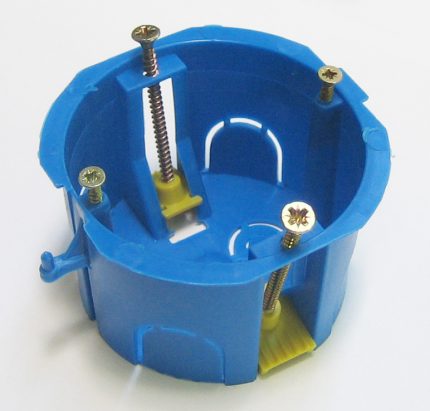
What form are manufactured products?
The greatest distribution was gained by round-shaped podrozetniki. For them, it is very simple to make a hole in the wall using a variety of devices.
Round glasses can be used both for mounting a single outlet or switch, or combine them into groups, connecting to each other by means of docking nodes.
Square boxes, although not used as often, have certain advantages. Their volume is much larger, so you can hide a lot of wires in them.
Often they are used for mounting system elements "smart House". There are single and group podrozetniki square shape, designed to install up to five outlets.
On sale there are oval boxes, which, like square ones, have a large internal space. They are convenient in that you can immediately plug in a double outlet. All the products described above are mounted on walls and are used for concealed wiring.
There is another type of mounting boxes, which stand somewhat apart - plastic covers or in other words multi-boxes, designed for open installation on the baseboard. They are designed for one or multiple outlets and usually have a square shape.
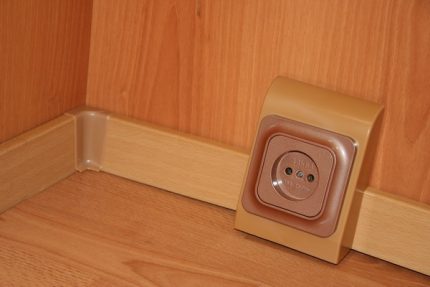
Outside sockets have two modifications - designs with installation up to the middle of the baseboard or to the floor. Since multiboxes are mounted on top of the baseboard, their distinguishing feature is aesthetic appeal and original design.
Installation Box Size
An important parameter of the sockets is their size, which are selected based on the specific installation conditions. The plug is 60-70 mm in diameter and 25-80 mm in depth.
Standard designs have external dimensions of 45 x 68 mm, while taking into account that the internal depth in this case will be 40 and the diameter 65 mm.
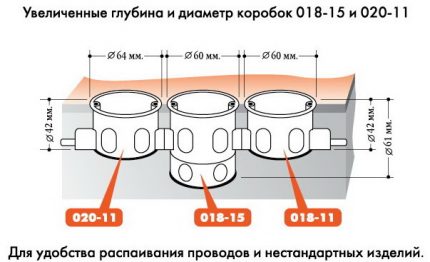
Oversized glasses, the depth of which is about 80 mm, it is advisable to apply when there is no junction box in the wiring, and the socket itself performs its functions. As for square products, then, as a rule, they have a size of 70x70 or 60x60 mm.
Mounting Box Material
The most popular are podrozetniki made of non-combustible plastic. They can be installed in concrete walls and structures made of composite materials.
There are also metal boxes that used to be ubiquitous in the old days, but today plastic products have almost replaced them.
Metal sockets are usually installed during installation. electrical wiring in wooden houses. They are made of galvanized or non-ferrous metal and can not be welded, so the connection to a metal pipe is made by soldering.
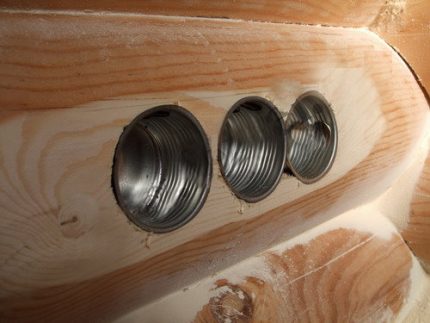
The basic rules for installing the socket
Before installing the socket, it is necessary to choose the place of its installation. But since the outlet is a source of increased danger, special requirements are laid down for its placement in some rooms, prescribed in "Rules for the installation of electrical installations" (PUE).
According to the PUE:
- from the electrical outlet to the pipe through which the gas passes, there must be a distance of at least 50 cm;
- sockets in the bathroom can be installed at a distance of at least 60 cm from the source of spray (washbasin, shower, bath);
- installation of switches is recommended to be done from the side where the door handle is located, while distance from device to floor should be up to 100 cm;
- Do not install outlets in saunas, baths, and rooms where washing is done.
There are no special rules for the rest of the rooms. Place the sockets in such a way that their use is convenient for all family members.
It is also necessary to be guided by safety requirements, and to install devices taking into account the location of household appliances in the house so that their cords reach outlets without the use of extension cords.
You may also be interested in information on installation details. sockets for washing or electric sockets.
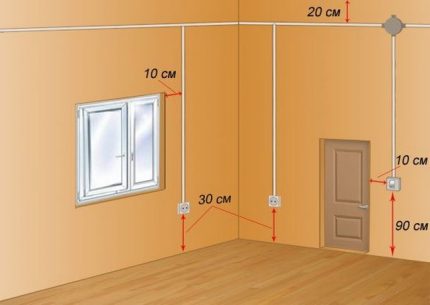
Installation of a socket box in a concrete base
If you have already decided where your sockets will be located, you can start installation work, which consists of several stages.
Before installing the socket in concrete, marking is done, then a hole is made in the wall and a gypsum mortar is prepared.
Step # 1 - marking up the wall
The sequence of work on the markup is as follows:
- use a tape measure to measure the distance from the floor to the intended installation location of the undergrowth;
- if the flooring has not yet been laid, then it is necessary to add another 5 cm;
- using the construction level, draw two lines: horizontal and vertical with the intersection point in the place where the box will be installed;
- attach the glass to the wall and circle it with a pencil.
If you have to install two or more sockets, then first with the help of the construction level a horizontal line is drawn. It should be located at that distance from the floor on which the sockets will be placed.
Find the center of the first box and draw a vertical line through it. Then set aside exactly 71 mm and draw a second vertical. In this place the center of the second glass will be located. The marking of the following sockets is carried out similarly.

Step # 2 - punching a hole in concrete
There are several ways to make holes in a brick or concrete wall. The simplest of them - with the help of a crown on concrete with victorious teeth, with which it, crashing into the wall, makes a circle of the right size.
In the center of the crown there is a drill from Pobedit for making a central hole.
Since standard sockets have an outer diameter of 67-68 mm, a crown with a diameter of 70 mm is suitable for work. The nozzle is put on a punch or drill, set on a marked line and make a hole.
Then the nozzle is pulled out, and the entire concrete layer remaining there is knocked out of the hole with a chisel and hammer.
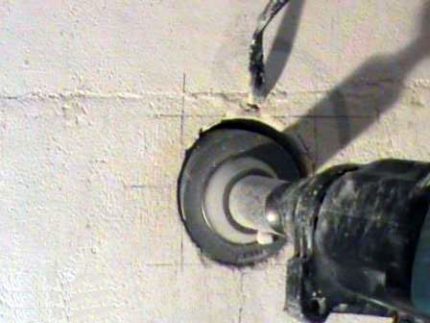
If there is no crown on concrete, then you can make a hole with a drill with a drill. First, a central hole is drilled to the entire depth of the nozzle, and then holes are made with the same drill along a circle line.
The more of them, the easier it will be to hollow out the hole of the desired diameter and depth with a chisel with a hammer or punch.
Another way is to make a square hole with a grinder with a nozzle in the form of a diamond disk. First, the central lines are cut, and then - along the entire perimeter of the undergrowth. The process as always ends with a chisel with a hammer.
Step # 3 - installing the box in the wall
After the hole is made, it needs to be cleaned well and inserted into it the socket for fitting. It should enter freely in width, and a depth of about 5 mm for the solution should remain in depth.
If everything turned out as it should, then now you need to make a passage for laying the wire from the top or bottom of the hole (depending on the location in the wiring room).

The rosette also needs to be prepared. Turn it over with the bottom side, where the slots for the wires are located and cut one of them with a knife. We put a wire there and insert the box into the wall for verification.
To fix the glass, prepare a solution of gypsum or alabaster, which should have a sour cream consistency. It is worth considering that the solution of these materials hardens very quickly, and you have no more than three to four minutes to complete the installation process of the undergrowth. Five minutes later, the mixture will be unusable.
Two minutes before putting the box into the wall, the hole is wetted with water. After the liquid is absorbed, a layer of gypsum is applied to its walls with a spatula. A wire is threaded into the glass, its rear part is also smeared with a solution, and the undergrowth is inserted into the hole.
Adjust the position of the box so that its edge is flush with the wall and the cogs are horizontal.
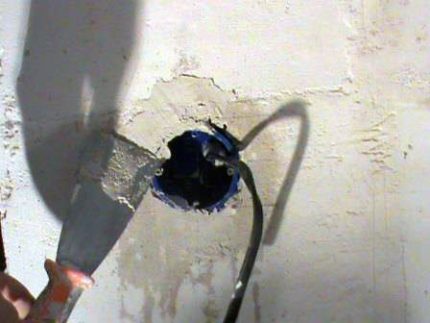
Step # 4 - Combining Multiple Sockets
How markup of two or more sub-rosettes is performed has been described above. Holes are made in the same ways as for a single box. The only difference is the need to combine the holes with each other. This can be done with a chisel or grinder.
Before installation, the sockets must be docked to each other using a side fastener. Wall mounting is the same as installing a single cup.
An important point that you must pay attention to when attaching the block of boxes is the strict horizontal position of the socket outlets during their fixation in the wall with gypsum mortar. It is necessary to carry out this part of the installation only with the help of the building level.
Installing boxes in hollow walls
Podrozetniki designed for walls made of composite materials, in particular plasterboard, have a slightly different design than installation boxes for concrete and brick foundations.
The glass is fixed in the wall without gypsum mortar, which allows installation of a socket box in drywall much faster and easier.
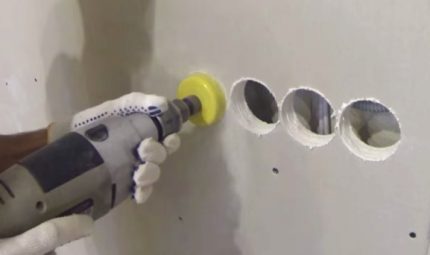
At the top of the glass there are four cogs arranged in pairs. Two of them protrude a little outside and are intended for mounting a switch or outlet.
The other two are slightly recessed into the body of the socket. On the bottom of each screw there is a metal or plastic foot, which, when the screw is rotated, sets in motion and fixes the box in drywall.
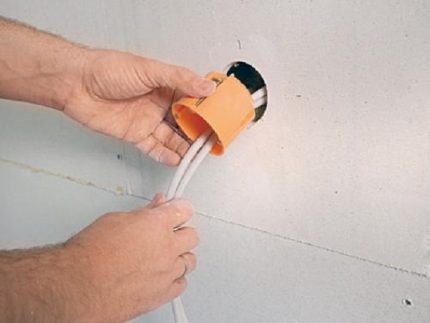
Before installing the socket, make the markup as described above. It is much easier to make a hole in drywall than in a concrete wall. You can simply cut a circle with a knife or drill a contour with a drill, and then cut it with the same knife.
However, when using these methods, not very smooth edges are obtained. In addition, drywall - the material is quite fragile and can break.
It is best to do the job with a wood crown. After the hole is prepared, remove the wire into it and insert the socket box so that the screws are horizontal. Lock the glass in drywall by turning the two recessed screws clockwise.
Installation of socket boxes in ceramic tiles
If it is necessary to install a socket or switch in the wall, which is supposed to be tiled, marking and making holes in concrete is carried out before the start of finishing work. In the resulting recesses, electrical wires are laid in advance.
After laying the tiles, marking is done again, and holes of the required depth are drilled in it. It is best to drill a tile with a diamond crown, periodically cooling it with water.
A gypsum mortar is placed in the recesses, it is also applied to the back of the socket, and then the box is pressed into the hole and leveled.
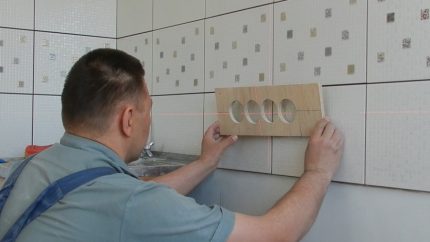
The nuances of installing a multibox on the baseboard
What to do if a high-quality repair has already been made in the house, but one more point was needed to connect electrical household appliances?
In this case, it is not necessary to strip off the new wallpaper and ditch the wall; you can make a socket directly on the baseboard.

However, it should be noted that this method can only be used on collapsible plastic baseboards with a cable channel. Before installing the socket, it is necessary to lay the wire inside the baseboard.
To do this, remove the cover from the part in which the socket will be located. This operation is performed from the corner or from the nearest plug, just pry off the cover with a screwdriver and carefully remove it.
Cut the skirting so that a gap is formed whose width matches the dimensions of the plastic lining. Insert a multibox into it, thread a wire into the hole in its body, and fix the socket with dowels.
Conclusions and useful video on the topic
How to install the sockets in a concrete wall, you can see in the following video:
The whole process of mounting a block of socket boxes in drywall is described in detail in the video:
The installation of the plastic overlay on the baseboard is shown in the video:
To find out how the installation of podrozetniki in the tiles, see the video
The installation of the socket boxes, although it seems at first glance very simple, has its own difficulties and nuances that must be taken into account during operation, so that after a while it is not necessary to re-breed the dirt and reinstall the shattered devices.
The durability and appearance of the socket or switch depends on how correctly and correctly installed the sockets are installed..
You yourself put the house in the concrete or brick wall at home? Or maybe they mounted a sock in drywall? Share your experience, tell us about the difficulties that arose during the installation process. Your advice will be useful to many beginners - leave your comments under this article.

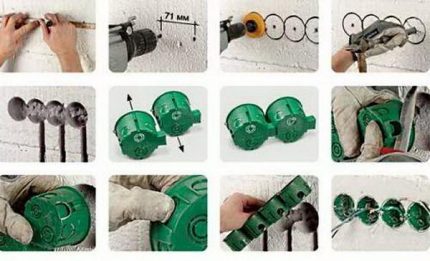
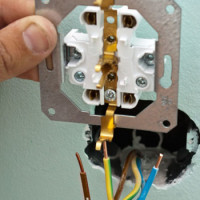 How to make two from one outlet and how to properly conduct an outlet from an outlet
How to make two from one outlet and how to properly conduct an outlet from an outlet 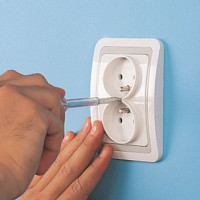 How to connect a double outlet: installing a double outlet in one socket
How to connect a double outlet: installing a double outlet in one socket  Installing a socket for a washing machine in the bathroom: an overview of the technology of work
Installing a socket for a washing machine in the bathroom: an overview of the technology of work 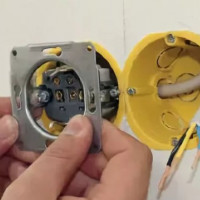 How to install a socket in drywall: installation rules and tips for installing a socket
How to install a socket in drywall: installation rules and tips for installing a socket  Installation of sockets in the bathroom: safety standards + installation instruction
Installation of sockets in the bathroom: safety standards + installation instruction  How to change and remodel the outlet: step-by-step instructions on how to replace
How to change and remodel the outlet: step-by-step instructions on how to replace  How much does it cost to connect gas to a private house: the price of organizing gas supply
How much does it cost to connect gas to a private house: the price of organizing gas supply  The best washing machines with dryer: model rating and customer tips
The best washing machines with dryer: model rating and customer tips  What is the color temperature of light and the nuances of choosing the temperature of the lamps to suit your needs
What is the color temperature of light and the nuances of choosing the temperature of the lamps to suit your needs  Replacement of a geyser in an apartment: replacement paperwork + basic norms and requirements
Replacement of a geyser in an apartment: replacement paperwork + basic norms and requirements
First of all, I do not understand why sockets in modern apartments are installed so close to the floor. After all, it is very inconvenient during installation and repair. In my opinion, it is not safe for young children. I do not see a single argument for. As for the sockets, the only problem I encountered was a mismatch in the size of the socket and the sockets. Some sockets cannot catch even with the antennae as wide as possible.
This is largely dictated by aesthetics - a socket at eye level spoils the look. Plus it’s also convenient. And for safety, there are sockets with child protection.
Hello. Outlets close to the floor are installed by those who do not want wires hanging ugly along the wall. At least, many are guided by this principle. But in fact, it is also convenient. For example, you need to stretch an extension cord from one room to another. Or it will lie on the floor or hang in the middle of the room, you see, 1 option is more comfortable. Also with a wired vacuum cleaner.
As for children ... When connecting a TV, for example, it’s much more convenient and safer to hide the outlet behind the cabinet on which the device is installed, and so on. That is, a plus for those outlets that can be hidden behind furniture, it is more difficult for a child to get there. When the device is in the public domain, you can buy “child protection” - it’s cheap and quite reliable. Checked. As for the sockets, such a problem exists, yes. But it is solved very simply - by purchasing high-quality devices, even more expensive in price.
Good afternoon, Michael. Sockets mounted near the floor were brought by perestroika - European-quality repairs began, and the masters recommended following European standards. If you look, it turns out that such an arrangement of sockets, switches is beneficial for wiring located inside the baseboards - the wire is saved.
PUE, by the way, does not force to follow foreign standards, and the requirements for the placement of sockets, switches, are very "democratic". For residential premises, the Rules recommend the height of the outlets, taking into account the interior, convenience, purpose. True, a height of more than a meter is considered impractical. Here for schools, kindergartens, the height of the outlet is regulated 1.8 meters. The height of the circuit breakers is even less limited.
A screenshot of the PUE attached.
I make repairs in the apartment. I got to the installation of the socket.I’m repairing it myself, to be honest, I don’t have information on how to install and fix them. Found on the Internet, where everything is phased written and stated. I found exactly those undergrowths that fit under my walls. It is also well described how to perform marking for installation of mounting boxes. Very useful information for those who, like me, are engaged in repairing on their own.
I myself changed the rosettes in the apartment and completely coped with the work. Facilitated the installation of the fact that the seats were made, as they were outdated podrozetniki. The main thing that needs to be done is to take the old socket and go to the store with it to pick a similar one. I think that those who are friends with a screwdriver should not have problems with the execution of this type of work.